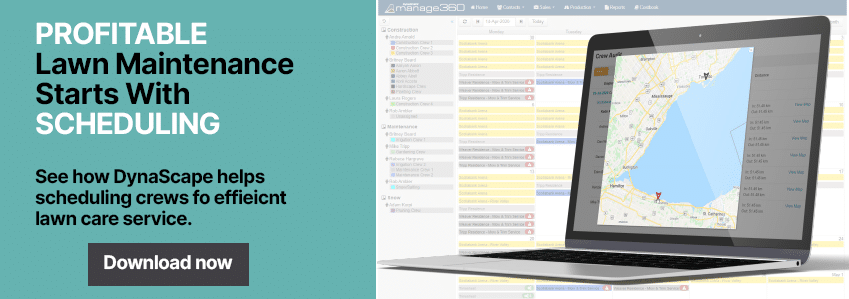Landscape maintenance is one of the fastest-growing services for landscaping companies. In the summer of 2021, 32% of landscaping companies reported that maintenance, including lawn cutting and hedge trimming, was their fastest-growing service.
Maintenance is one of the cornerstone pieces of any landscaping business, but also one that has plenty of competition because the entry point for cutting lawns is very low. To get the most profit from lawn maintenance, landscaping companies have to think about how to schedule their crews to make them profitable. This is because:
- Maintenance jobs can be very quick in nature
- Customers require return visits, sometimes weekly
- There are many jobs to schedule in a single day
- Competition can dig into your customer base
To schedule your lawn maintenance for profitability, you should be using landscaping scheduling software to drive your maintenance programs. In order to increase profitability, the focus should be on maintenance, mowing, and fertilization companies. If you aren’t scheduling for profitability, long-term growth for your business will be a struggle.

Here are some of the best ways to schedule for profitability and what you should be thinking about when it’s time to use landscaping scheduling software.
Aim for Route Density
There are two specific ways to become more profitable using landscape job scheduling software: cut expenses and take on more work. By aiming for a higher route density, you can get the best of both worlds.
Route destiny is the act of grouping together jobs that are close together into a compact group. That way, your crews spend less time driving from job to job. Packing jobs together can be crucial when working on smaller jobs, especially when crews routinely unload equipment, perform the job, reload the equipment back into the truck or trailer, and then move on. There isn’t time to waste in order to return higher profit margins.
The less time spent driving also means more time spent taking on more work. Or, in the case of slow work, the less time you are paying crews an hourly rate. Either you are cutting down expenses or increasing the number of customers you can take on in a day.
You can also go beyond simply grouping jobs together in the same location and get more advanced in route destiny planning by including like-minded jobs. That would mean properties and jobs of similar size would be grouped, keeping the crew size the same. There is nothing worse than having a crew member standing around because the job is too small or the job is too big, and it takes your small crew too much time to complete.
Optimize Routes, Including Jobs and Stops
Going a step further than route density is planning route optimization, which can be performed in your landscaping scheduling software. Route optimization builds the most efficient way your crews will take, going from job to job to job. It’s the next layer of route planning. It can cut driving time further than just grouping everyone in a dense area. Route optimization tells your crews which house or business to go to first, second, and third until the day is complete.
When planning routes, you can also include any stops that will need to be made, such as fuel stops for equipment and trucks, breaks, lunch locations, and any trips back to the office. Optimizing your routes will reduce drive times between jobs, giving you even more time back on the clock to take on additional work.

It’s worth driving your routes every so often to ensure they are the best ones to be taking. Do a drive-by and see if there are obstacles such as long traffic lights and zones to avoid that could slow down your trip. Then account for them in your route optimization planning.
Route optimization can lead to a 25% reduction in drive time while saving 10% on gas expenses. And better route optimization can, on average, lead to 21% more jobs scheduled during the day due to the additional time available.
The Cost of Unplanned Delays and Driving
Any kind of delay can be costly, especially when you consider the number of people in your crew and the amount of time wasted over the year due to delays. A study found that 2.62% of total drive time is taken up by delays, such as road restrictions and traffic congestion.
In a 40 hour work week, that amounts to about an hour of time wasted on unplanned delays. That may not seem like a lot until you sit down and calculate it. That’s 52 hours a year per crew member. The average landscaper rate in 2022 is $15 per hour, so for a crew of four, that amounts to around 208 combined hours wasted to delays, costing your business about $3,120 a year.
Businesses that run multiple crews can quickly amount to tens of thousands of dollars wasted on delays. If landscaping companies completed route optimization and planning, these overrun costs could be avoided.

Similar to gas, unplanned driving can eat away at profits. The same study found that 7.82% of driving distance is unplanned, including extra trips and other diversions. For example, if your crew is travelling 50 miles per day, that equals 3.91 miles per day or 19.55 miles per week of unplanned driving. So, over a year, your crews could put an extra 1,016.6 miles on your vehicles.
For a standard pickup truck that gets roughly 16 miles to a gallon, and the average price of gas being $3.30 a gallon, that equals an extra $209.67 per truck in fuel costs per year. The more trucks in your fleet and the larger the distance they travel in a day, the higher that expense can go. If you aren’t planning routes and keeping an eye on what delays could affect your crew’s performance, costs can quickly start to add up.
Optimize the Order of Service for Each Job
Once your crews arrive at a job, it’s essential to optimize the order of service they will perform. You can use checklists in landscaping scheduling software to keep crews on task and plan each job, much like you would route planning. You can even optimize each job down to the specific client.
Optimizing the order of service has proven to be a great move towards a more efficient business for many landscaping companies. Of course, every company is different, but it could be as simple as trimming first and then mowing second, so you don’t need to get as close to the edges. Then you don’t have to go back over with the mower if you missed a spot. It could also mean carrying out jobs in the order you pack the truck. Then you take equipment out in the reverse order you put them in. That way, you aren’t removing equipment you don’t need until the time you need it.
Crews will know their customers and can help you build the best order possible. Some might want to tackle trimming first, while others will pull weeds, provide pool services if available, and perform maintenance tasks first before finishing off with the mowing. Be flexible, but consider what your crews are doing at each job and how they can do it the fastest.
Organize Crews and Equipment for Each Day
Getting the day started right can be the most significant difference in how your crews perform. Especially if you are mixing and matching crews, having to fill vacancies on crews due to time off, or need to make a crew larger to accommodate larger jobs for the day.
In landscape scheduling software, start the day off right by organizing your crews before they arrive. If they use mobile applications, crew members can look at their apps, check what crew they are in, and get with their crew leader. There is no fumbling around for assignments or having to do roll-calls in the morning.
Many landscaping businesses that deploy landscaping scheduling software don’t have their crews meet at the office or yard. Instead, they meet from a more centralized location between all the crew members and start their routes from there, with the crew leader picking up equipment and supplies.
By using landscaping software, you can also plan out the equipment they will be taking for each day based on the information of the calls in front of you. By seeing the entire schedule for the day, you can pack exactly what they will need and use in the truck. This will reduce overpacking, where crews have to move around the equipment they aren’t using, and underpacking, where they may need to return to the yard to grab extra equipment.
Have Communication With Employees and Customers
Communication is critical both with your employees and your customers. Employees need to stay updated with important information to be efficient and successful. Likewise, to be successful, crews need to know of:
- Schedule changes for their current workday
- Additions to their schedule that could affect their route
- Customer delays
- Service changes
These points could drastically affect the routes they take, the number of crew members they need, the order of service, and which job they go to first. By using landscaping scheduling software equipped with mobile applications, crews can stay informed of changes by simply looking at their mobile device. As changes come in, the office can change routes and schedules and send crews where they need to be. They can also relay messages to the crews about additions, so they have all the information they need to finish the job.
To deliver the best service possible, communication with customers is critical. If you know who is coming up because you have a full calendar in your landscaping scheduling software, you can call or email customers in advance to see if there are any changes needed. This is a great opportunity to sell more services or products while simply reminding the customer you will be at their location on a specific day.
If the customer talks to a crew member for more service, the mobile application can relay information back to the office. This way, everyone is kept in the loop on what is happening in the field.
Making Smart Scheduling Choices Can Lead to Business Growth
To grow and scale your landscaping maintenance business, scheduling should be on the top of your mind. The best way to reduce expenses and free up more time for calls is to become an expert at scheduling, routing, and servicing by optimizing each area.
Landscape scheduling software such as DynaScape’s Manage360 can help you achieve new optimization levels in your scheduling to become more profitable. For example, users of Manage360 have been able to optimize routes and aim for high-density scheduling with Manage360’s scheduling function and crew mapping. This has led to more efficient planning because office dispatchers have all the data they need at their fingertips to make the best route and schedule possible.
Lawn maintenance businesses that want to become profitable have to remove the guesswork from their lawn maintenance scheduling. They do this by allowing landscape scheduling software to do some heavy lifting. Executing scheduling and route optimization while constantly communicating with crews and customers is the best strategy for growing your business’s bottom line.

